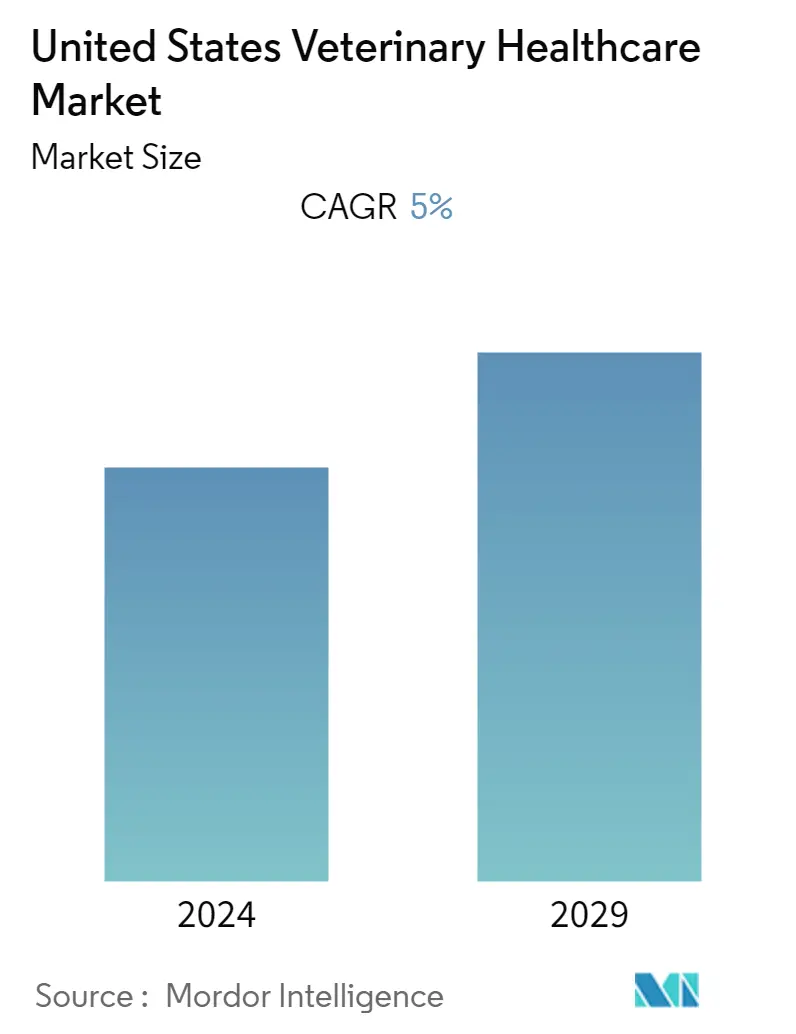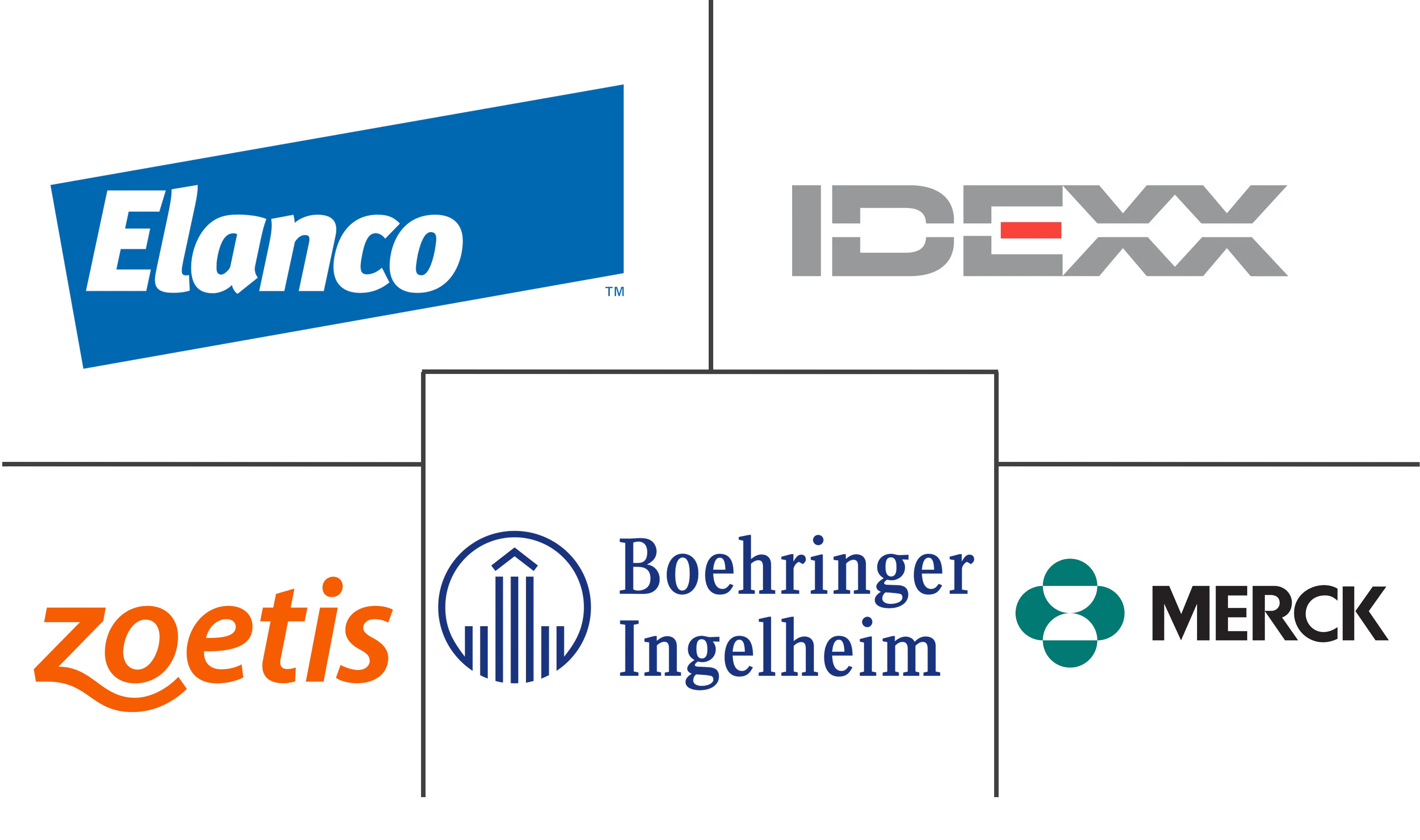Market Size of United States Veterinary Healthcare Industry

| Study Period | 2019 - 2029 |
| Base Year For Estimation | 2023 |
| Forecast Data Period | 2024 - 2029 |
| Historical Data Period | 2019 - 2022 |
| CAGR | 5.00 % |
Major Players
*Disclaimer: Major Players sorted in no particular order |
Need a report that reflects how COVID-19 has impacted this market and its growth?
US Veterinary Healthcare Market Analysis
The United States Veterinary Healthcare market is expected to register a CAGR of 5.0% during the forecast period (2022 - 2027).
The emergence of the COVID-19 pandemic has impacted the growth of the studied market. The lockdown in the country has affected the supply chain of pharmaceutical products and disrupted the services in veterinary centers and clinics. For instance, according to an article published in March 2021, titled 'Association between Experience of Pet Ownership and Psychological Health among Socially Isolated and Non-Isolated Older Adults', it has been found that socially isolated older adults without dogs were more likely to have lower psychological health than their peers who have or have had a dog in their life during the COVID-19 pandemic. Also, people have experienced some barriers to accessing veterinary care during a pandemic such as limited appointments due to government guidelines and some participants having to access emergency vet services which were more costly than regular visits and check-ups. Similarly, according to a survey by American Veterinary Medical Association, in May 2020, it has been observed that over 30% of the veterinary practices were done using telemedicine and only 20% were seeing emergency-related cases. Thus, COVID has significantly affected the market growth during the pandemic. However, the releasing of COVID-19 restrictions and resuming veterinary services as well as increased vet visits are expected to rise the demand for veterinary healthcare-related products and tests, which in turn is anticipated to propel the market growth during the forecast period.
The Centers for Disease Control and Prevention, recommended veterinary hospitals and clinics prioritize urgent and emergency visits and procedures. Moreover, pet adoptions increased during this pandemic situation. Several animal shelters, non-profit rescue organizations, private breeders, and pet stores observed increased consumer demand. Foster Inc., a non-profit organization, claimed to register more than 1,000% increase in foster applications during the lockdown period in New York, which was the epicenter of COVID-19 cases in the United States.
Certain factors that are propelling the market growth are advanced technology leading to innovations in animal healthcare, increasing productivity at the risk of emerging zoonosis, and increasing initiatives by the government and animal welfare associations.
The rising number of animal adoption in the country is expected to drive market growth. For instance, according to the 2022 statistics published by Best Friends Save Them All, it has been observed that 79 million cats and 108 million dogs were owned in the United States in 2021. Also, the Society for the Prevention of Cruelty to Animals, Los Angeles, reported that the rate of pet adoption doubled in June 2020, with daily adoptions of about 10 to 13 pets per day. The rising adoption of pets is expected to drive the demand for better healthcare facilities and treatments which in turn is anticipated to propel the market growth over the forecast period.
The United States is among the major regions across the world that highly support the healthcare of veterinary animals both in companion animals (e.g. dogs, cats, and horses) and production (e.g. cattle, pigs, sheep, poultry, etc.) of animal species categories.
A large population investing in pet insurance, across the developed markets, is also contributing to the market growth. For instance, as per the North American Pet Health Insurance Association (NAPHIA) State of the Industry Report 2022 Highlights, the total premium volume for pet insurance in the United States was USD 2.591 billion, and 3,979,282 pets were insured in 2021, with an increase of 28.3% as compared to 2020. In addition, as per the same source, California (19.3%), New York (8.4%), and Florida (6.1%) have the highest percentages of insured pets.
In addition, the government is taking various measures to enhance the management of animal healthcare, in terms of diagnosis and treatment. For instance, in September 2021, the Animal and Plant Health Inspection Service of the United States Department of Agriculture (USDA) planned to invest up to USD 500 million to proactively expand and coordinate monitoring, surveillance, prevention, quarantine, and eradication activities to stop the spread of African Swine Fever (ASF). Also, the American College of Veterinary Surgeons funded various projects in 2021, that primarily encourage surgeons to investigate varied topics related to animal health. This is expected to lead to better surgical care for animals.
Furthermore, the advancements of technologies in the animal healthcare sector, have been increasing over the period and have led to the development of smart wearable devices, livestock monitoring systems, electronic recording systems, and approval of new products which are expected to boost the market growth over the forecast period. For instance, in August 2021, Merck Animal Health, United States, launched WHISPER ON ARRIVAL, a precision tool that uses a wide range of variables to identify which cattle may be more susceptible to illness. This information can be used by farmers and veterinarians to plan a strategy for the management of bovine respiratory disease (BRD), one of the most common diseases in beef cattle. Additionally, in May 2020, the United States Food and Drug Administration approved Felix Pharmaceuticals' Enrofloxacin Flavored Tablets, for the treatment of bacterial diseases in pets and domestic animals.
Moreover, in January 2020, Zoetis, a leading animal health company further expanded its poultry vaccine portfolio with the introduction of Poulvac Procerta HVT-ND, a vectored recombinant vaccine for protection against Newcastle and Marek's disease viruses. With the rising number of owners, product approvals, and support from the government, the studied market is expected to grow in the United States over the forecast period.
However, high costs related to animal testing are expected to impede market growth over the forecast period.
